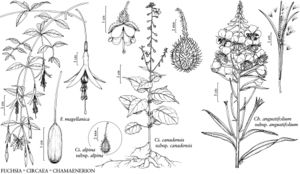Fuchsia
Sp. Pl. 2: 1191. 1753.
| Taxon | Illustrator ⠉ | |
|---|---|---|
 | Fuchsia magellanica Circaea canadensis subsp. canadensis Circaea alpina subsp. alpina Chamaenerion angustifolium subsp. angustifolium |
Shrubs, [lianas, epiphytes, or trees]. Stems scandent, [erect, ascending, pendant, or decumbent], branched. Leaves cauline, opposite or whorled [alternate]; stipules present, usually deciduous; petiolate; blade margins serrulate to crenate-dentate [entire]. Inflorescences solitary flowers in leaf-axils [racemes, panicles, or involucrate when flowers numerous]. Flowers bisexual and protogynous [or unisexual (and plants gynodioecious, dioecious, or subdioecious)], actinomorphic, buds pendent; floral-tube deciduous (with sepals, petals, and stamens) after anthesis, well developed, cylindrical to obconical, with basal nectary, adnate or mostly free, nectary unlobed or shallowly 4–8-lobed; sepals 4, reflexed or spreading singly in anthesis; petals 4, [minute or absent], dark purple [shades of purple, red, or orange, rarely lavender, green, or rose-pink]; stamens 8, in 2 unequal series, [in equal series, or shorter whorl reflexed into floral-tube], anthers basifixed, pollen shed singly; ovary 4-locular, stigma subentire or 4-lobed, clavate [capitate or globose], surface wet and non-papillate. Fruit a fleshy berry, oblong [to ellipsoid or subglobose]; pedicellate. Seeds few to ca. 500, in 2 to several rows per locule, rarely in 1 row, embedded in pulp. = 11.
Distribution
Introduced; Mexico, West Indies (Hispaniola), Central America, South America, Pacific Islands (New Zealand), Pacific Islands (Society Islands), also in w Europe (Ireland), Asia (India), e, s Africa, Pacific Islands (Hawaiian Islands), Pacific Islands (New Zealand), Australia
Discussion
Species 107 (1 in the flora).
Nearly three-fourths of the species of Fuchsia occur in the northern Andes of South America, where the largest section (sect. Fuchsia) is centered. Other species occur in New Zealand (3 spp.), the Society Islands (1 sp.), Mexico, Hispaniola, Central America, and the southern Andes. All species of Fuchsia share the strong morphological synapomorphy of a fleshy berry, a fruit type unique in the family. Most species of Fuchsia characteristically have 2-aperturate pollen [3-aperturate pollen in the polyploid sections Kierschlegeria (Spach) Munz and Quelusia (Vandelli) de Candolle], are usually shrubs or subshrubs, sometimes lianas or trees, and have prolonged floral tubes on flowers that are mostly purple, red, or orange, and generally with petaloid sepals. Within the Circaeeae, P. E. Berry et al. (2004) found strong support for a monophyletic Fuchsia.
Selected References
None.